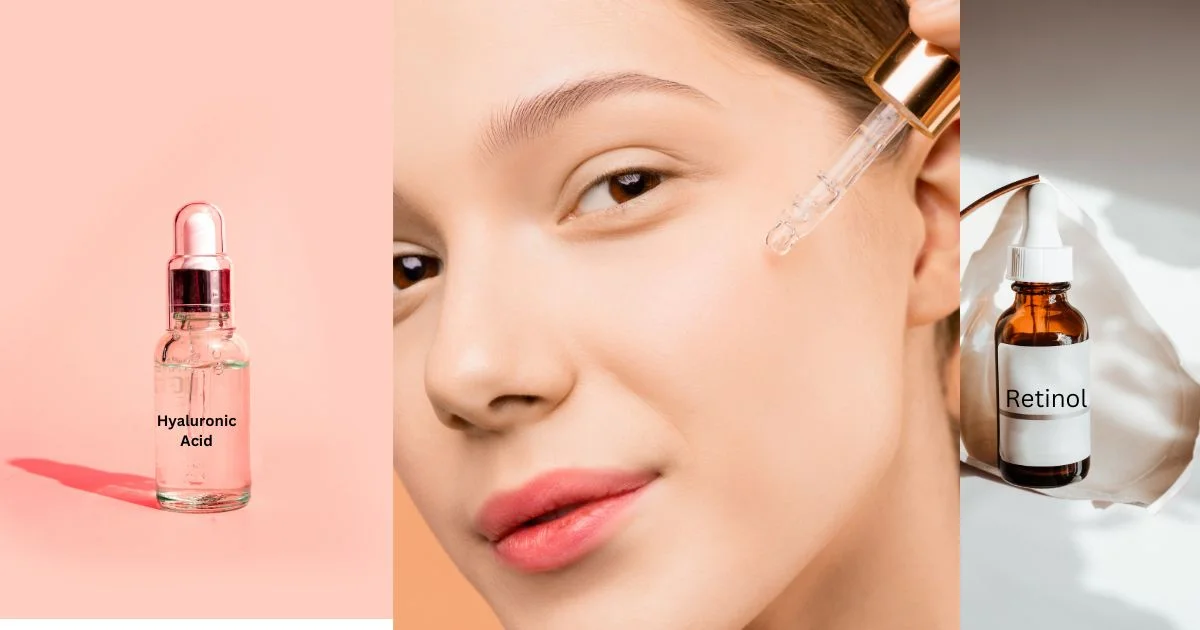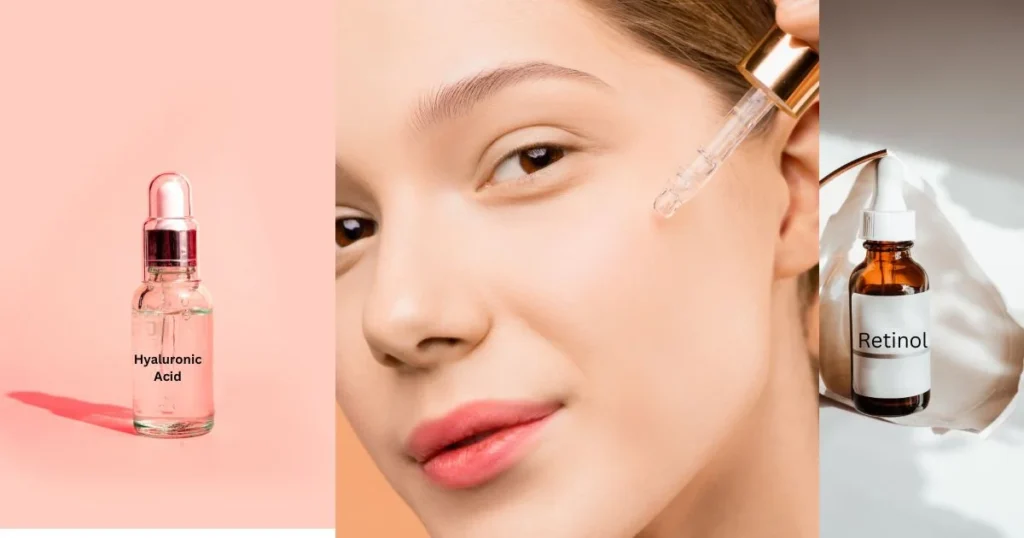Hyaluronic Acid and Retinol: Unlocking the Secrets to Youthful Skin
When it comes to achieving youthful and radiant skin, two ingredients have gained significant attention in the skincare world: hyaluronic acid and retinol. These potent compounds offer a myriad of benefits and are often regarded as essential components of any effective skincare routine. In this article, we will delve into the fascinating world of hyaluronic acid and retinol, exploring their individual properties, combined synergies, and how to incorporate them into your daily skincare regimen.
 What is Hyaluronic Acid?
What is Hyaluronic Acid?
The Role of Hyaluronic Acid in Skin Health
Hyaluronic acid is a naturally occurring substance found in our bodies, particularly in the skin, connective tissues, and eyes. It plays a vital role in maintaining hydration, firmness, and elasticity within the skin. Despite its name, hyaluronic acid is not an exfoliating acid like alpha or beta hydroxy acids; instead, it is a moisture-binding humectant.
You may also like..Retinol Body Lotion: Unlocking the Secrets to Youthful Skin Can Niacinamide and Retinol be used together?The Dynamic Duo for Skincare Can Retinol and Vitamin C be used together?10 Effective Benefits Niacinamide and Glycolic Acid:10 effective benefits of the Power Duo for Skin Care Can Niacinamide and Salicylic Acid be used together? 10 Powerful benefits
Benefits of Hyaluronic Acid for Skin
When applied topically, hyaluronic acid has numerous benefits for the skin. It has the remarkable ability to attract and retain moisture, which helps to plump up the skin and reduce the appearance of fine lines and wrinkles. Additionally, hyaluronic acid promotes a healthy skin barrier, improves texture and tone, and soothes irritated or inflamed skin.
The Magic of Retinol
The Science Behind Retinol
Retinol, a derivative of vitamin A, is a powerful antioxidant that has revolutionized the field of skincare. Its unique molecular structure allows it to penetrate the skin’s surface and work its magic in the deeper layers. Retinol stimulates collagen production, accelerates cell turnover, and helps to fade hyperpigmentation, resulting in smoother, more youthful-looking skin.
How Retinol Works on the Skin
Retinol works by binding to specific receptors in the skin, which triggers a cascade of biochemical reactions. These reactions promote collagen synthesis, increase cell renewal, and regulate sebum production. The cumulative effect is improved skin texture, diminished wrinkles, and a reduction in the appearance of age spots.
Benefits of Retinol in Skincare
Retinol offers a multitude of benefits for the skin. It helps to minimize the signs of aging, including fine lines, wrinkles, and uneven skin tone. Retinol also unclogs pores, making it an effective treatment for acne-prone skin. Furthermore, it enhances skin radiance, promotes a more even complexion, and improves overall skin texture.
Hyaluronic Acid and Retinol: A Dynamic Duo
- Wrinkle reduction: Retinol, a form of vitamin A, stimulates collagen production and promotes cell turnover, reducing the appearance of fine lines and wrinkles. Hyaluronic acid helps to hydrate and plump the skin, further diminishing the look of wrinkles.
- Skin firmness: Retinol improves skin elasticity by boosting collagen and elastin production. Hyaluronic acid complements this effect by providing additional moisture and supporting the skin’s structure, resulting in firmer and more supple skin.
- Improved texture: Retinol promotes the shedding of dead skin cells and encourages the growth of new, healthy cells. This, combined with the hydrating properties of hyaluronic acid, helps to improve skin texture, making it smoother and more even.
- Enhanced skin hydration: Hyaluronic acid is a humectant that attracts and retains moisture, keeping the skin hydrated and plump. Retinol helps strengthen the skin barrier, reducing water loss and maximizing the hydrating benefits of hyaluronic acid.
- Brightened complexion: Retinol promotes cell turnover, leading to a brighter and more radiant complexion. Hyaluronic acid helps to improve skin tone and texture, resulting in a more youthful and glowing appearance.
- Reduced hyperpigmentation: Retinol can help fade dark spots, sunspots, and other forms of hyperpigmentation by accelerating the skin’s natural exfoliation process. Hyaluronic acid contributes to a more even skin tone and can help fade discoloration.
- Smoother skin: Both hyaluronic acid and retinol contribute to smoother skin by promoting cell turnover and improving the skin’s texture. They can help minimize the appearance of roughness, bumps, and acne scars.
- Improved acne management: Retinol has anti-inflammatory properties that can help reduce acne breakouts and regulate oil production. Hyaluronic acid, on the other hand, provides lightweight hydration without clogging pores, making it suitable for acne-prone skin.
- Skin rejuvenation: The combined effects of hyaluronic acid and retinol can lead to overall skin rejuvenation. They help address multiple signs of aging, such as wrinkles, dullness, uneven tone, and loss of firmness, resulting in a more youthful and revitalized complexion.
- Complementary effects: Hyaluronic acid and retinol work synergistically, with hyaluronic acid providing hydration and moisture to counteract the potential drying effects of retinol. Using them together can create a balanced and effective skincare routine.
Incorporating Hyaluronic Acid and Retinol into Your Skincare Routine
- Choosing the Right Products
When selecting hyaluronic acid and retinol products, it’s important to consider their concentrations and formulations. Opt for products that contain stable forms of retinol and hyaluronic acid, as these are more effective and less likely to cause irritation. Start with lower concentrations and gradually increase them as your skin becomes accustomed to the ingredients.
- Application Techniques
To maximize the benefits of hyaluronic acid, apply it to clean, damp skin. This will help lock in moisture and ensure optimal hydration. Retinol, on the other hand, should be applied to dry skin in the evening, as it can be photosensitive. Follow the instructions provided with each product and allow sufficient time for absorption before applying additional skincare products.
Frequency of Use
Begin by using hyaluronic acid and retinol products a few times a week and gradually increase the frequency as tolerated by your skin. Some individuals may experience mild irritation or dryness initially, but this usually subsides with continued use. If irritation persists, reduce the frequency or consult a dermatologist for personalized advice.
Common Misconceptions and Concerns
Can Hyaluronic Acid and Retinol be Used Together?
Yes, hyaluronic acid and retinol can be used together. In fact, they complement each other beautifully. Hyaluronic acid provides hydration and counteracts any potential dryness or irritation caused by retinol. Applying hyaluronic acid first, followed by retinol, allows for optimal absorption and ensures the benefits of both ingredients are maximized.
Side Effects and Precautions
Although hyaluronic acid and retinol are generally well-tolerated, some individuals may experience mild side effects. These can include temporary redness, dryness, or flaking. It is important to introduce these ingredients gradually and monitor your skin’s response. If any severe irritation occurs, discontinue use and consult a dermatologist.
Hyaluronic Acid and Retinol for Different Skin Types
Hyaluronic acid and retinol can benefit various skin types, including dry, oily, and combination skin. However, individuals with sensitive or highly reactive skin should exercise caution and start with lower concentrations. It is advisable to perform a patch test before applying these ingredients to your entire face.
Tips for Maximizing the Benefits
- Hydration and Moisture
In addition to using hyaluronic acid and retinol, maintaining proper hydration is essential for healthy skin. Drink an adequate amount of water daily and consider using a humidifier in dry environments to prevent moisture loss from the skin. Hyaluronic acid works best when the skin is well-hydrated.
- Sun Protection
Both hyaluronic acid and retinol increase the skin’s sensitivity to the sun. Therefore, it is crucial to apply a broad-spectrum sunscreen with a high SPF during the day. This will protect your skin from harmful UV rays and prevent further damage.
- Consistency is Key
To experience optimal results, consistency is key. Incorporate hyaluronic acid and retinol into your daily skincare routine and use them consistently over time. Skincare is a long-term commitment, and the benefits of these ingredients will become more evident with regular use.
Conclusion
Hyaluronic acid and retinol are powerful skincare ingredients that can transform your skin and give it a more youthful appearance. By understanding their individual benefits and using them in conjunction, you can unlock the secrets to radiant and healthy skin. Remember to choose the right products, follow proper application techniques, and be consistent in your skincare routine. Embrace the power of hyaluronic acid and retinol, and watch your skin flourish with renewed vitality.
Disclaimer: The information provided above is for educational purposes only and should not be considered as medical or professional advice. Individual experiences may vary, and it’s always recommended to consult a healthcare professional or dermatologist for personalized guidance and recommendations regarding skincare ingredients and treatments. Use hyaluronic acid and retinol products as directed and perform a patch test before use to check for any potential adverse reactions.
FAQs
Can I use hyaluronic acid and retinol if I have sensitive skin?
Yes, but it is advisable to start with lower concentrations and perform a patch test before applying them to your entire face. If irritation occurs, discontinue use and consult a dermatologist.
How long does it take to see results from hyaluronic acid and retinol?
Results can vary depending on individual factors and the specific products used. Generally, noticeable improvements in skin texture and hydration can be observed within a few weeks of regular use.
Can I use hyaluronic acid and retinol in my morning skincare routine?
While hyaluronic acid is suitable for morning use, retinol is best used in the evening due to its photosensitivity. Always follow the instructions provided with each product for optimal results.
Are there any natural alternatives to hyaluronic acid and retinol?
Yes, there are natural alternatives to hyaluronic acid, such as aloe vera and honey, which offer moisturizing properties. For retinol, natural alternatives include rosehip oil and bakuchiol, although their efficacy may vary.


 What is Hyaluronic Acid?
What is Hyaluronic Acid?

